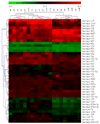MicroRNA 133B targets pro-survival molecules MCL-1 and BCL2L2 in lung cancer
- PMID: 19654003
- PMCID: PMC2824514
- DOI: 10.1016/j.bbrc.2009.07.143
MicroRNA 133B targets pro-survival molecules MCL-1 and BCL2L2 in lung cancer
Abstract
Lung cancer is the most frequent cause of cancer-related death in this country for men and women. MicroRNAs (miRNAs) are a family of small non-coding RNAs (approximately 21-25nt long) capable of targeting genes for either degradation of mRNA or inhibition of translation. We identified aberrant expression of 41 miRNAs in lung tumor versus uninvolved tissue. MiR-133B had the lowest expression of miRNA in lung tumor tissue (28-fold reduction) compared to adjacent uninvolved tissue. We identified two members of the BCL-2 family of pro-survival molecules (MCL-1 and BCL2L2 (BCLw)) as predicted targets of miR-133B. Selective over-expression of miR-133B in adenocarcinoma (H2009) cell lines resulted in reduced expression of both MCL-1 and BCL2L2. We then confirmed that miR-133B directly targets the 3'UTRs of both MCL-1 and BCL2L2. Lastly, over-expression of miR-133B induced apoptosis following gemcitabine exposure in these tumor cells. To our knowledge, this represents the first observation of decreased expression of miR-133B in lung cancer and that it functionally targets members of the BCL-2 family.
Conflict of interest statement
The authors have no conflicts of interest to declare
Figures




Similar articles
-
microRNA-1/133a and microRNA-206/133b clusters: dysregulation and functional roles in human cancers.Oncotarget. 2012 Jan;3(1):9-21. doi: 10.18632/oncotarget.424. Oncotarget. 2012. PMID: 22308266 Free PMC article. Review.
-
Down-Regulation of MicroRNA-133b Suppresses Apoptosis of Lens Epithelial Cell by Up-Regulating BCL2L2 in Age-Related Cataracts.Med Sci Monit. 2016 Nov 1;22:4139-4145. doi: 10.12659/msm.896975. Med Sci Monit. 2016. PMID: 27802259 Free PMC article.
-
MiR-133b is down-regulated in human osteosarcoma and inhibits osteosarcoma cells proliferation, migration and invasion, and promotes apoptosis.PLoS One. 2013 Dec 31;8(12):e83571. doi: 10.1371/journal.pone.0083571. eCollection 2013. PLoS One. 2013. PMID: 24391788 Free PMC article.
-
Identification of miRNomes in human stomach and gastric carcinoma reveals miR-133b/a-3p as therapeutic target for gastric cancer.Cancer Lett. 2015 Dec 1;369(1):58-66. doi: 10.1016/j.canlet.2015.06.028. Epub 2015 Aug 11. Cancer Lett. 2015. PMID: 26276722
-
MicroRNA-125b promotes apoptosis by regulating the expression of Mcl-1, Bcl-w and IL-6R.Oncogene. 2013 Jun 20;32(25):3071-9. doi: 10.1038/onc.2012.318. Epub 2012 Jul 23. Oncogene. 2013. PMID: 22824797
Cited by
-
Noncoding RNAs: the shot callers in tumor immune escape.Signal Transduct Target Ther. 2020 Jun 19;5(1):102. doi: 10.1038/s41392-020-0194-y. Signal Transduct Target Ther. 2020. PMID: 32561709 Free PMC article. Review.
-
MiR-133b targets antiapoptotic genes and enhances death receptor-induced apoptosis.PLoS One. 2012;7(4):e35345. doi: 10.1371/journal.pone.0035345. Epub 2012 Apr 20. PLoS One. 2012. PMID: 22532850 Free PMC article.
-
microRNA-1/133a and microRNA-206/133b clusters: dysregulation and functional roles in human cancers.Oncotarget. 2012 Jan;3(1):9-21. doi: 10.18632/oncotarget.424. Oncotarget. 2012. PMID: 22308266 Free PMC article. Review.
-
Cancer and neurodegenerative disorders: pathogenic convergence through microRNA regulation.J Mol Cell Biol. 2011 Jun;3(3):176-80. doi: 10.1093/jmcb/mjq058. Epub 2011 Jan 28. J Mol Cell Biol. 2011. PMID: 21278200 Free PMC article. Review.
-
The role of microRNAs in the regulation of apoptosis in lung cancer and its application in cancer treatment.Biomed Res Int. 2014;2014:318030. doi: 10.1155/2014/318030. Epub 2014 Jun 5. Biomed Res Int. 2014. PMID: 24999473 Free PMC article. Review.
References
-
- Jemal A, Siegel R, Ward E, Hao Y, Xu J, Thun MJ. Cancer statistics. CA Cancer J. Clin. 2009 - PubMed
-
- Calin GA, Dumitru CD, Shimizu M, Bichi R, Zupo S, Noch E, Aldler H, Rattan S, Keating M, Rai K, Rassenti L, Kipps T, Negrini M, Bullrich F, Croce CM. Frequent deletions and down-regulation of micro- RNA genes miR15 and miR16 at 13q14 in chronic lymphocytic leukemia. Proc. Natl. Acad. Sci. U. S. A. 2002;99:15524–15529. - PMC - PubMed
-
- Di Leva G, Calin GA, Croce CM. MicroRNAs: Fundamental facts and involvement in human diseases. Birth Defects Res. C. Embryo. Today. 2006;78:180–189. - PubMed
-
- Krutzfeldt J, Stoffel M. MicroRNAs: a new class of regulatory genes affecting metabolism. Cell Metab. 2006;4:9–12. - PubMed
-
- Calin GA, Liu CG, Sevignani C, Ferracin M, Felli N, Dumitru CD, Shimizu M, Cimmino A, Zupo S, Dono M, Dell'Aquila ML, Alder H, Rassenti L, Kipps TJ, Bullrich F, Negrini M, Croce CM. MicroRNA profiling reveals distinct signatures in B cell chronic lymphocytic leukemias. Proc. Natl. Acad. Sci. U. S. A. 2004;101:11755–11760. - PMC - PubMed
Publication types
MeSH terms
Substances
Grants and funding
LinkOut - more resources
Full Text Sources
Other Literature Sources
Medical
Research Materials

